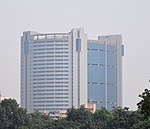Anglo Arabic Senior Secondary School
1696 establishments in Asia1949 establishments in IndiaEducational institutions established in the 1690sHigh schools and secondary schools in DelhiUse Indian English from June 2018

The Anglo Arabic Senior Secondary School or more commonly, Anglo Arabic School, is a co-educational government aided school in New Delhi, India. The school is managed by Delhi Education Society. Prof. Najma Akhtar is the president of the School Managing Committee and Prof. Mohd Muslim Khan is the manager of the school. It was founded in 1696 by Ghazi ud-Din Khan Feroze Jung I.
Excerpt from the Wikipedia article Anglo Arabic Senior Secondary School (License: CC BY-SA 3.0, Authors, Images).Anglo Arabic Senior Secondary School
Shraddhanand Road, Delhi Old Delhi
Geographical coordinates (GPS) Address Nearby Places Show on map
Geographical coordinates (GPS)
| Latitude | Longitude |
|---|---|
| N 28.646 ° | E 77.2229 ° |
Address
Anglo Arabic Public School
Shraddhanand Road
110006 Delhi, Old Delhi
Delhi, India
Open on Google Maps








